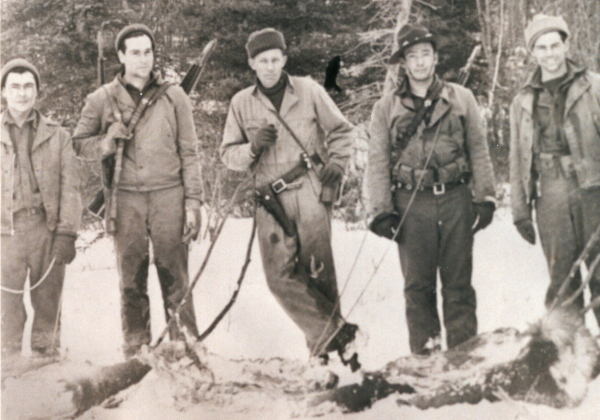
It wasn’t easy to become an Alaska Scout. The qualifications were stringent, and Castner handpicked them all—trappers, hunters, fishermen, dogsledders, miners, and prospectors. He also chose Native Alaskans—Aleuts, Eskimos, and American Indians. “They have one thing in common,” he said. “They’re tough.”
George Gray had the qualities Castner was looking for. Gray was a prospector, Alaska homesteader, and an expert at wilderness survival. When he joined the army in 1942, he taught soldiers field sketching, scouting and patrolling, skiing, snowshoeing, and signaling, among other military subjects. Within his first few months in the army, Gray was asked if he wanted to transfer to the Scouts. “I should say so, emphatically!” he replied. “Within 30 minutes I had an application for transfer on the first sergeant’s desk.”
One trait Gray and the other Scouts shared was their dislike of the military’s rules and regulations. The Scouts seldom used rank and they didn’t wear uniforms. Some preferred to wear fringed buckskin jackets and cowboy-styled hats. “We’re a punk-looking outfit,” said Larry Beloff, an owner of two gold mines in Alaska who was nicknamed Diamond Jim because he always wore a diamond ring and a diamond-studded watch. “I guess the Army never saw anything like us before. When the colonel picked us out, the brass hats took one look and threw up their hands.”
“We didn’t have any insignias, because the more insignias you have, then that’s the first one to get shot,” said Sergeant Ed Walker, who was a hulking 6 foot 4 inches tall and an accomplished basketball and football player. Walker found the regular army uniform ill-fitting, and was relieved to be able to wear whatever he wanted.
Even Colonel Castner didn’t wear any rank or identifiers. One day, while he was down by the creek scrubbing a frying pan, a soldier came up and asked Castner what unit he was with.
“Castner’s Scouts,” he replied.
“Castner’s Scouts?” the soldier said. “I saw a couple of them guys; looks like Castner’s Cutthroats to me.”
The name stuck. One Cutthroat who epitomized this image was Castner’s right-hand man, the hard-bitten and fiercely loyal Major William J. Verbeck. Verbeck was fluent in the language and customs of Japan, having lived there as a boy. Verbeck was also a highly skilled warrior, and it was his job to teach the Cutthroats how to fight like commandos.
The Cutthroats were taught how to handle all types of weapons and allowed to carry any one they wanted. Verbeck always carried a knife, which a surgeon had custom designed for him so that when he stabbed someone the blade would go in and out with ease. George Gray and Simeon “Aleut Pete” Pletnikoff each chose to carry an M1 semi-automatic rifle. It was a reliable gun—unless sand got in it—and it could be filed down, making it fully automatic. Ed Walker opted for a Browning Automatic Rifle (BAR), which had consequences he hadn’t initially anticipated. “I chose the BAR, which can spit out 20 rounds of ammunition swiftly,” he said. “So I was in the number-one boat every blasted landing we made.”
The first secret landing that Castner’s Cutthroats made was on Adak, in the central Aleutians. The United States desperately needed an airstrip closer to Kiska and Attu to launch bombing raids against the Japanese invaders. The Cutthroats were sent in to scout and survey the unmapped island.
In the middle of the night on August 28, 1942, two submarines surfaced with 37 Cutthroats on board. They climbed into five rubber rafts and paddled through the icy water, four miles to shore. There were no Japanese on Adak, and the U.S. Army quickly moved in and built an airstrip.
Soon after, the Cutthroats scouted and secured the island of Amchitka to the west, just 45 miles from Kiska, where the army built another airstrip and began bombing Kiska, and later Attu. The United States also set up a naval blockade to prevent Japanese supply ships from reaching the islands. But the occupying forces continued to hold on.
The Americans decided to reclaim Attu first, and devised a plan—Operation Sandcrab—involving a three-pronged attack on the Japanese garrison under the command of Colonel Yasuyo Yamazaki. To carry out the attack, the army called in a combat-ready force: the 7th Infantry Division, stationed at Fort Ord, California. The troops, approximately 15,000 in all, were divided into three groups: the Northern Force, the Southern Force, and the Provisional Scout Battalion. The Southern Force was to sweep through Attu’s Massacre Valley and advance to the northwest to meet up with the Northern Force and Scout Battalion near the center of the eastern portion of the island. Together, they would move toward Chichagof Harbor, trapping the Japanese.
Castner’s Cutthroats would lead the way.




